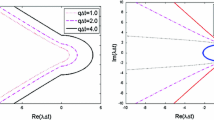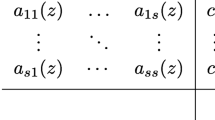Abstract
This paper discusses explicit embedded integration methods with large stability domains of order 3 and 4. The high order produces accurate results, the large stability domains allow some reasonable stiffness, the explicitness enables the method to treat very large problems, often space discretization of parabolic PDEs, and the embedded formulas permit an efficient stepsize control. The construction of these methods is achieved in two steps: firstly we compute stability polynomials of a given order with optimal stability domains, i.e., possessing a Chebyshev alternation; secondly we realize a corresponding explicit Runge-Kutta method with the help of the theory of composition methods.
Similar content being viewed by others
References
S. N. Bernstein,Leçons sur les propriétés extrémales et la meilleure approximation des fonctions analytiques d'une variable réelle, in Professées á la Sorbonne, Paris, 1926.
E. Hairer, S. P. Nørsett, and G. Wanner,Solving Ordinary Differential Equations I. Nonstiff Problems, 2nd ed., Springer-Verlag, Berlin, 1993.
E. Hairer and G. Wanner,Solving Ordinary Differential Equations II. Stiff and Differential-Algebraic Problems, 2nd ed., Springer-Verlag, Berlin, 1996.
P. J. van der Houwen and J. Kok,Numerical solution of a maximal problem, Report TW 124/71, Mathematical Center, Amsterdam, 1971.
P. J. van der Houwen,Construction of Integration Formulas for Initial Value Problems, North-Holland, Amsterdam, 1977.
P. J. van der Houwen and B. P. Sommeijer,On the internal stability of explicit m-stage Runge-Kutta methods for large m-values, Z. Angew. Math. Mech., 60 (1980), pp. 479–485.
V. I. Lebedev and A. A. Medovikov,Methods of second order accuracy with variable time steps, Izvestiya Vuzov, Matematika, N10, Russia, 1995.
V. I. Lebedev,How to solve stiff systems of differential equations by explicit methods, in Numerical Methods and Applications, CRC Press, Boca Raton, 1994, pp. 45–80.
V. I. Lebedev,Zolotarev polynomials and extremum problem, Russ. J. Numer. Anal. Math. Modelling. V. 9, N 3 (1994), pp. 191–314.
V. I. Lebedev,A new method for determing the roots of polynomials of least deviation on a segment with weight and subject to additional conditions. Part I, Part II, Russ. J. Numer. Anal. Math. Modelling. V. 8, N 3 (1993), pp. 195–222; V. 8, N 5 (1993), pp. 397–426.
V. I. Lebedev,Explicit difference schemes with time-variable steps for the solution of stiff system of equations, Preprint DNM AS USSR N177, 1987.
H. Lomax,On the construction of highly stable, explicit numerical methods for integrating coupled ordinary differential equations with parasitic eigenvalues, NASA Technical Note NASATND/4547, 1968.
A. A. Markov,Lectures on the functions of least deviation, 1892; in Selected Works, OGIZ, Moscow, 1948, pp. 244–291, (in Russian).
A. A. Medovikov,Explicit and explicit-implicit methods of solution of unstationary problems, PhD Thesis, INM, Moscow, 1992.
C. L. Metzger,Méthodes de Runge-Kutta de rang supérieur à l'orde, Thèse (troisième cycle), Université de Grenoble, France, 1967.
W. Riha,Optimal stability polynomials, Computing, 9 (1972), pp. 37–43.
G. Szegö,Orthogonal Polynomials, Amer. Math. Soc., New York, 1949.
P. L. Chebyshev,On the problems about minimal values connected with appropriate representation of functions, Mem. Acad. St. Petersburg (1859); Collected Works, Vol. 2, GITTL, Moscow-Leningrad, 1947 (in Russian); Oeuvres, Vol. I, p. 271.
P. L. Chebyshev,On the functions slightly deviating from zero for certain values of the variables, Prilojenie k XI tomy Zapisok Imperatorskoi Akademii nauk N3 (1881);Collected Works, Vol. 3, GITTL, Moscow-Leningrad, 1948, p. 108; Oeuvres, Vol. II, p. 373 (in Russian).
J. G. Verwer,A class of stabilized three-step Runge-Kutta methods for the numerical integration of parabolic equations, J. Comput. Appl. Math., 3 (1977), pp. 155–166.
J. G. Verwer,Explicit Runge-Kutta methods for parabolic partial differential equations, 1996. To appear in the Runge-Kutta centennial special issue of Appl. Numer. Math.
E. I. Zolotarev,On applying elliptic functions to the study of functions of least and greatest deviation from zero, Zapiski Sankt-Peterburgskoi Akademii Nauk XXX, No 5 (1887), pp. 1–59 (in Russian).
Author information
Authors and Affiliations
Additional information
Communicated by Syvert P. Nørsett.
This work was supported by the Russian Fund Fundamental Researches and the Swiss National Science Foundation 20-43.314.95.
Rights and permissions
About this article
Cite this article
Medovikov, A.A. High order explicit methods for parabolic equations. Bit Numer Math 38, 372–390 (1998). https://doi.org/10.1007/BF02512373
Received:
Revised:
Issue Date:
DOI: https://doi.org/10.1007/BF02512373




